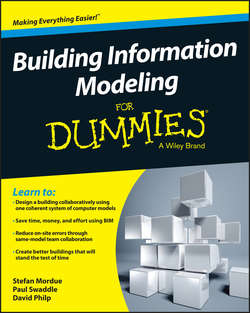Читать книгу Building Information Modeling For Dummies - Swaddle Paul - Страница 4
На сайте Литреса книга снята с продажи.
Part I
Getting Started with Building Information Modeling
Chapter 1
Defining Building Information Modeling (BIM)
ОглавлениеIn This Chapter
▶ Exploring what BIM actually is
▶ Comprehending how BIM can help you
▶ Explaining the BIM plans and strategies you need to be successful
▶ Getting excited about BIM and encouraging others
The construction industry has been doing things the same way for thousands of years. Concrete is poured and set, bricks are stacked on top of bricks, and systems for heating and water are designed around corners and over multiple floors. For way too long, the construction industry has done a lot of these processes in isolation. At its worst, the construction industry brings some people involved in the construction of an asset like a building or a bridge onto the project just in time for their part, and the project team has to work around decisions or redo work, often on-site and under pressure of project deadlines.
Even in some of the most collaborative schemes, communication between different teams still has a long way to go, and the other users of building data and outputs, like clients and facility managers, are sometimes the last to know. The quality and quantity of data they receive on a project can vary wildly. What you need is a way to involve the entire project team earlier and coordinate all the project information in clear and accessible forms.
If only a combination of processes and technology existed that provided the framework to improve communication and data exchange across the construction industry, no matter how large or complicated projects may be. Well, interestingly enough, you’re in luck. This chapter serves as your jumping-off point to that very process: Building Information Modeling, commonly shortened to BIM.
